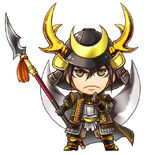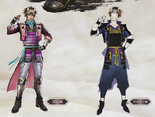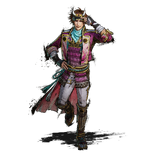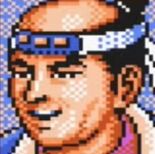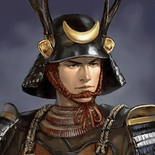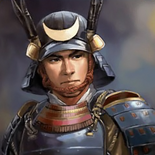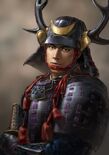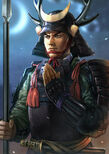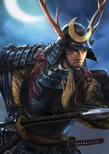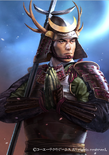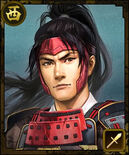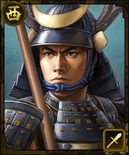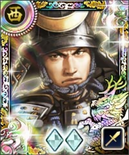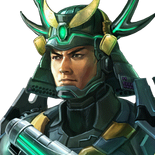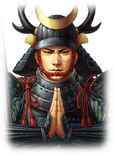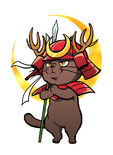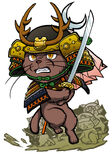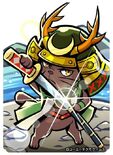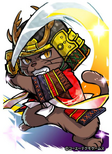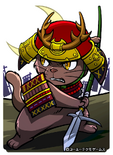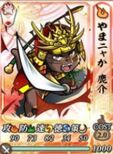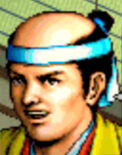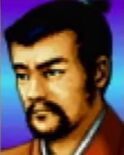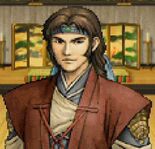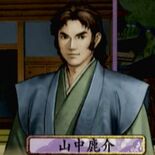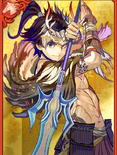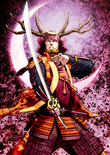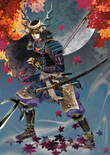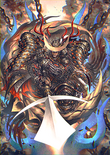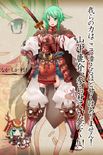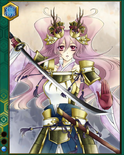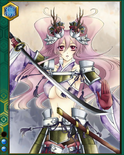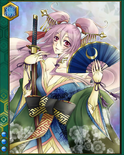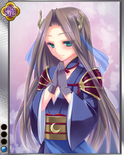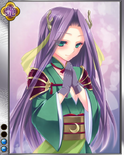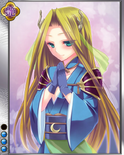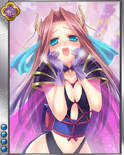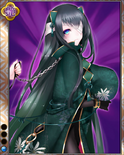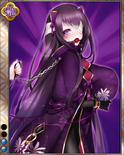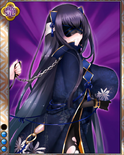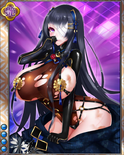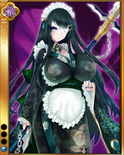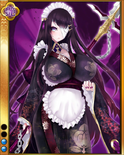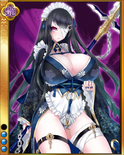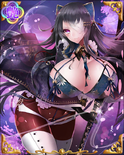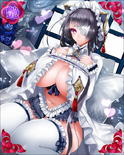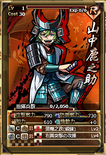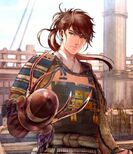| Shikanosuke Yamanaka | |
| Clan(s)/Alliance(s): | Yamanaka Amago |
|---|---|
| Weapon(s): | Twin Katana |
| Significant Battle(s): | |
| Playable Debut: | Samurai Warriors 5 |
| Real name: | Yamanaka Yukimori
|
| Japanese name: | 山中 幸盛
|
| Born: | September 20, 1545
|
| Died: | August 20, 1578
|
| Birth year is debated between the years 1544 or 1545. Birth date is disputed. | |
Shikanosuke Yamanaka (山中 鹿之助, Yamanaka Shikanosuke) is a young Amago general famous for his impressive courage and attractive looks. Known as the "Kirin Child of Sain'in", he is best known for resisting the Mōri and trying to restore the Amago's relevancy until his dying days. Whether he actually did any of the wondrous acts he is known for, however, is still unknown and debated to this day.
Prior to his playable appearance in the Samurai Warriors games, he has been a generic NPC since Samurai Warriors 2.
His Nobunaga's Ambition counterpart is thirty-second place in Gamecity's character popularity ranking for 2015. The Nobunaga no Yabou 201X poll for 4-star officers puts him in fifty-eighth place. He placed forty-fourth in the Nobunaga no Yabou Taishi poll for most favorite father and ninth for best subordinate.
Role in Games[]
Samurai Warriors[]
Shikanosuke makes a minor appearance as one of the male samurai bodyguards the player can earn and purchase in the Shop during the second title. During the game's first Empires installment, he appears as a spear-wielding officer in the Unification Of Chugoku scenario serving under the Amago clan.
Depicted as a self-righteous general who hates the Mōri, he is responsible for introducing Nobunaga to Motonari within the latter's story in Sengoku Musou 3: Empires. Motonari is weary of dealing with Nobunaga and Shikanosuke simultaneously, as the younger man's bravery and talents are admirable yet futile. After suffering defeat in the field of battle, Shikanosuke condemns Motonari's actions and falls with the Amago clan.
For his fourth title and 4-II battle appearances, Shikanosuke is an irate and impatient warrior. He ventures to do everything himself and tries to win through persistence and brute strength. Motonari and Takakage take advantage of his short fuse for their strategies. The fifth 4-II downloadable scenario counts Shikanosuke as an attractive man; his rage towards the rabble beating the tea party's guests sends him into battle.
In Samurai Warriors 5, the playable Shikanosuke was guarding Gassantoda's mountain path when he mistakes Mitsuhide Akechi and Toshimitsu Saitō for members of the Mōri and attacks them. Once the misunderstanding is cleared, he takes his new acquaintances to Katsuhisa Amago, who is struggling against Motonari's forces.
Despite the new reinforcements, the tactical brilliance of Motonari prevails and the battle-weary Amago forces make Katsuhisa submit to the Mōri. Shikanosuke is allowed to wander to pursue his own ideals. Mitsuhide sympathizes with Shikanosuke's personal frustrations of his failure and allows him to join his return to Echizen and becomes stronger.
Still hoping to revive the Amago clan, Shikanosuke agrees and would accompany the Asakura reinforcements of Kenshin Uesugi in Kawanakajima. Kenshin's devotion to finding his own righteousness and justice inspires both Shikanosuke and Mitsuhide to find the cause they would devote themselves to.
When Nobunaga Oda invades Ōmi, Shikanosuke joins Mitsuhide in putting a stop to the invasion and subsequently joins the Oda alongside his friend. As a member of the Oda, Shikanosuke suggests an assault on the Mōri-held Gassantoda castle, the Amago's former castle. Nobunaga agrees and has Mitsuhide and Mitsuki accompany him while Shikanosuke finds Katsuhisa, now a resident in Kyoto, and several Amago retainers that escaped. Once again the Mōri family's superior intellect wins the day and Shikanosuke and other retainers are all captured.
Despite Motonari's attempts to convince the youth to surrender, Shikanosuke flatly refuses and eventually escapes Odaka Castle with other captured Amago officers. Shikanosuke works his way to Tanba where he reunites with Mitsuki and Mitsuhide. He quickly notices that Mitsuhide had grown much colder during his imprisonment, but Shikanosuke notices his friend had also become much stronger and closer to his own goal of the land's unification. Doubts over whether he should still support Mitsuhide are cleared at Shigisan Castle, where Mitsuhide's concern for Mitsuki allows Shikanosuke to see that his friend's heart was still present underneath.
When his lord is besieged at Kōzuki Castle, Shikanosuke rushes forward beyond the allied forces to rejoin his lord against the Mōri. Surprisingly, the vanguard of the northern frontier at Harima, Nagaharu Bassho defects, and Nobunaga orders the troops to abandon Kōzuki Castle and head for Harima. Unable to abandon his lord, Shikanosuke seals off the escape point as soon as his allies leave and promises to rejoin them once he rescues Katsuhisa.
Ultimately, his attempt is for naught as the Mōri's endless waves are too much for his lord. An enraged Shikanosuke would bravely face Motonari in combat and mortally wounds his foe but is shot down from behind by the daimyo's men. Shikanosuke's death angers Mitsuki into leaving the Oda while Mitsuhide's internal doubts emerge due to his friend's death.
Shikanosuke has a special scenario showing an alternative perspective of Kōzuki Castle, where Nobunaga's request for reinforcements comes much later into the battle. Because of this, Mitsuhide orders the rest of the troops to depart ahead and chooses to help Shikanosuke finish the battle and rescue Katsuhisa. With Motonari finally dead, Shikanosuke apologizes for being so weak as to need Mitsuhide's strength to finish his dream, but Mitsuhide thanks Shikanosuke's passion for always driving him forward.
He also appears as part of the Oda's reinforcements at revised Yamazaki.
Kessen[]
In Kessen III, Nobunaga has the chance to recruit him for his army. During the Battle of Akashi in the game's eighth chapter, first head to the northern village on the map. After hearing the tale of Shikanosuke's reluctant participation, the player may then march south and defeat Takaie Shishido. Free to do as he pleases, the general decides to repay the Oda army's kindness by serving in their ranks. He leads a spear unit, and his beginning stats are strongest out of all the optional generals in the game.
Nobunaga's Ambition[]
Throughout the series, he is referred to by his famous name. He has spectacular stats for war in Chūgoku, not so much in domestic affairs. His act of declaring his service to the Amago and his death are often mentioned as historical events in the series.
For the newest title, Shikanosuke is called by his real name, Yukimori. He happily offers his service to Yoshihisa Amago. A man of action who prefers to ask questions later, he hops at any chance to prove himself in battle. Yoshihisa scorns his lack of refinement and subtlety, but he applauds his general's charisma for it helps innovate the troops. Though clumsy while expressing his gratitude, Yukimori admires his master and loves to eat up praise. The retainer acts as a constant aid to Yoshihisa throughout the "what if?" events in the game.
Should Yoshihisa succeed in defeating Motonari, a boastful Yukimori will berate their western rival as a pitiful man. The retainer is surprised when his lord speaks in favor of his rival and reconciles his differences with Motonari. After Yoshihisa becomes the lord of the Western regions, Yukimori seems to have learned from the experience. When his lord asks him what purpose war has, he believes showing mercy after decimating an opponent is pivotal for truly understanding them. Comprehending their views leads to much needed respect and peace. Pleased by his retainer's response, they return to celebrating their victory with the rest of the Amago vassals.
Nobunaga no Yabou 201X has him act as one of three stars for the Amago Heroes event. Shikanosuke and his comrades wish to better protect their master and visit the SLO headquarters to plead for training. Director Isurugi leads the eager trio to the base's VR educational center and subjects them to challenging UMA simulations. Shikanosuke's unique feat is resisting the simulation's paralyzing ailment through sheer willpower. He helps the protagonist beat the test and frees his shocked allies from their trance.
Mōri Motonari: Chikai no Sanshi[]
By the time Shikanosuke is born into the world in Mouri Motonari: Chikai no Sanshi, his father dies while fighting Motonari's army. Years later, a young Shikanosuke is raised by his widowed mother in Izumo and overhears gossip of Suke Sugishige's defeat in battle. Realizing it is only a matter of time before the Mōri reach his home, Shikanosuke informs his mother of his intentions of joining the samurai class. The young boy's goal is to join the Amago and avenge his father's death by Motonari's hand. His mother finds it pointless to try to dissuade him, so she hands him Narimitsu, a treasured sword left to her by Shikanosuke's father.
Inspired by Narimitsu, Shikanosuke completes his training during his teenage years. He says his farewell to his mother and his childhood friend, Shino. Shino worries for his safety, but he assures her he will prevail. Without delay, he announces himself before the Amago head and is admitted into their army as a stalwart general. He participates in the defense for Shiraga and Gassantoda Castle. With the Amago clan abolished after their subsequent defeats, he flees from capture and meets with other Amago survivors. Asking that they seek help from the Ōtomo or Tachibana, Shikanosuke volunteers to head to Kyoto and search for the heir of the Amago family. His desire is to restore the Amago back to power, eventually staging an all out attack on the Mōri base of operations at Fubeyama. Cursing his third failure, Shikanosuke avoids being captured by cutting open a path for his dramatic escape. An elderly Motonari is shaken by the youth's frightening strength and regrets not taking his life.
Hiding back in Kyoto, Shikanosuke reunites with Shino -who searched for him after he left- and lives together with her. He spends his days living with her in peace since he is unable to contact his allies. Hearing news of Motonari's death and Terumoto's leadership, he feels his dream of avenging his father is stolen away from him. However, he resolves to march out to battle again when he learns the location of the newly designated Amago heir, Katsuhisa Amago, from Ekei. Bidding farewell to Shino, who is pregnant with his child, Shikanosuke pays a visit to Nobunaga to ask assistance. Under Hideyoshi's command, they proceed west and quickly take back former Amago territory, Kōzuki Castle. Given charge of protecting the position, he and three other members of the Amago Ten Braves guard Katsuhisa at the castle.
When Hideyoshi abandons them during the Mōri siege, the Amago are isolated and outnumbered by the Mōri army. Shikanosuke is captured and taken to Terumoto personally. The young lord doesn't wish to see the general die a needless death and asks Shikanosuke to serve him. Shikanosuke, feeling completely defeated and thinking of his promise to return alive to Shino, quickly agrees. While Terumoto believes Shikanosuke's reply and is delighted, the veteran Mōri vassals whom remember Shikanosuke's past vigor find the claim hard to swallow. Therefore, without Terumoto's knowledge, they order for Shikanosuke's assassination in the mountain path. The ninja are sent to do their job and, though Shikanosuke puts up a strong resistance, he is fatally wounded. Left for dead, Shikanosuke spends his last moments yelling his lover's name in agony.
His legacy remains with his son who is dubbed the "Second Shikanosuke". His son, who is the spitting image of his father, joins forces with Ieyasu to avenge his father. Whilst in a disguise, he attempts to assassinate an unguarded Motoharu Kikkawa. Shikanosuke's son reveals his identity while fighting Terumoto's army at Sekigahara. At first, he is mistaken for being his father but closer inspection from Mōri vassals dissolves their early presumptions. When defeated, Shikanosuke's son dies from his wounds on the field.
Personality[]
Voice Actors[]
- Kenji Nojima - Mōri Motonari: Chikai no Sanshi
- Yōhei Azakami - Samurai Warriors 5
- Jun Kasama - Shin Nobunaga no Yabou
Live Action Performers[]
Quotes[]
- "Shikanosuke, I'm impressed you can pray with such focus. It wouldn't hurt to take a breather though."
- "Nonsense. Until the Amago are restored, I will boldly face any obstacle."
- "That's great and all, but things won't get better if you're being too hard on yourself. It's night so go to sleep."
- "I haven't rested since I swore for restoration three months ago. If you would excuse me..."
- "He's so uptight about everything. Reminds me of a lot of Kanbei."
- ~~Hanbei and Shikanosuke; 100man-nin no Sengoku Musou
Historical Information[]
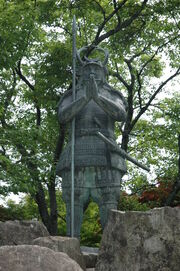
Bronze statue of Yukimori at Gassantoda Castle.
Personal Info[]
Yamanaka Yukimori was the second son of Yamanaka Mitsuyuki. His mother was Nami (also called Tsunetsune), Tachihara Tsunashige's daughter. Both father and son were said to have served the Amago clan based in Izumo since their early days of service. Yukimori was said to have been a beautiful man who stunned observers with his good looks. According to the Meishou Genkouroku, Yukimori also possessed an attractive mustache and kept it finely trimmed at all times. His facial hair was in such fine shape that a single hair from his face could pierce through a shouji door.
His impressive courage was known during his early years and several favorable expectations were placed on his shoulders. A particular episode describes a stern Yukimori after hearing the news of his older brother's death, wherein he faced a Yamanaka deer antler helmet on the night of a crescent moon. The bold imagery is one of the reasons why he is associated with a crescent moon and said helmet. He was said to have frequently prayed to the crescent moon for success in his campaigns. Famed for his services within the Amago, he was one of the star generals in the Amago Ten Braves. Yukimori was known as an Amago loyalist and exhausted himself in his fight for the restoration of the Amago name.
While the former paragraphs list the common interpretation of Yukimori, modern research has led to several doubts on its historical authenticity. One of the main reasons historians question the history's accuracy is due to the sources of the records mentioning Yukimori. A majority of them were authored during the Edo Period, nearly two centuries after his death and during a time when fictional yet well known tales for figures of the period began (i.e.: Hideyoshi looking like a monkey, Ieyasu looking like a tanuki, etc.).
The other problem lies in the nature of these "records", or gunki-monogatari, which are stories known for stressing heroism and distorting facts to better fit a romantic image. While each record claims to accurately describe the events that occur with a poetic narrative, conflicting accounts over Yukimori's activities are repeatedly found within them -particularly over the nature of his activities in battle. Like other titles of its nature, the idea of the Amago Ten Braves rank is only found in folklore and fiction. Even the existence of Yukimori's father and his clan have been disputed due to their near absence in historical records surrounding the Amago clan.
On the other hand, there are few historical records accepted within the realm of "accuracy" that actually do mention Yukimori. The most popular note about him comes from the Nobunaga Kouki. After Yukimori's death, Hideyoshi was said to have held a grudge against his lord. Nobutada mentioned that the death worsened his father's image. It is likely from these reactions that the popular heroic image of Yukimori took its roots. However, there is a massive amount of ambiguity in regards to Yukimori being involved with the statement, and its meanings are still argued to this day. With knowledge of any other records bearing his mention scarce and Nobunaga Kouki mentioning brief details, the stories told about him in gunki-monogatari are accepted as "facts" in a sense. In any case, the stories found within them are so far hard to completely argue against with currently known historical evidence.
Yukimori's wife was the daughter of Kamie Hidetsuna, an Amago vassal who was the overseer of Noto Province. He fathered two sons and one daughter. He adopted a daughter who became Kamei Korenori's wife.
Other Names[]
Shikanosuke (鹿介) was Yukimori's legal alias. The common spelling found today (鹿之助) is an invention of the Edo Period. It strives to not only make his name easier to read and pronounce, but it also presents an overtly masculine image for him. The Edo Period tales particularly favor Yukimori as a tragic hero, stating his loyalty strove him to fight for an already lost cause. Due to the familiarity of the name with the public, historians may include the romanticized Shikanosuke spelling when addressing Yukimori.
The idea of Yukimori's nickname (山陰の麒麟児, Sainin no Kirinji) ties into the same folklore created generations after his death. The term, kirin child, is a synonymous term for "child prodigy". In Yukimori's case, the name is used to describe the young man's admirable courage and to celebrate the countless amount of people he killed. The origin of the nickname is uncertain, some arguing it has its source from Kuroda Yoshitaka or Akechi Mitsuhide's commentary about Yukimori. A minor opinion is that Yukimori invented the name himself. Another nickname for him, "Tiger of Izumo" (出雲の虎, Izumo no Tora), appears within Amago records.
His childhood name was supposedly Jinjirou (甚次郎).
Early Career[]
Due to the status of Yukimori's appearances in historical records, the following sections will include the various legends told about Shikanosuke.
Yukimori was born in the Yamanaka mansion at Shingukutani, Izumo, roughly located in modern day Yasugi, Shimane. When he was approximately two years old, his father was said to have died due to illness. Missing a father figure has led to many legends about Yukimori's mother. At all times, she would remind her son of the Yamanaka's ties to the Amago clan and reproached any lackadaisical behavior. However, she would take Yukimori to social gatherings within the mansion and taught him to be kind and courteous, especially during hard times, to those around him. She reasoned a sound and happy army would be more willing to fight for him. Her teachings became a strong doctrine throughout Yukimori's later career.
When Yukimori was still a young boy, he was invited by his eldest brother, Yukitaka, into the best room of their family mansion. Waiting for him was his mother who gave permission for him to look at the alcove of the room. When Yukimori looked, he saw a tall deer antler helmet adorned with a crescent moon emblem. Yukitaka informed the boy that the helmet was the treasure of their family name. Granting the helmet to the child, the elder brother expressed confidence in his sibling's potential as a capable general. He wanted the boy to use the helmet at ten years of age and bring honor to their family. Nami then labeled the Mōri their mortal enemies and stressed they be eradicated for the new age of their Amago masters. Moved by their expectations, Yukimori swore to not fail them.
An alternative version of the tale is partially inscribed earlier. Yukitaka was previously the clan head but grew weak from illness and died. Thereafter, a stoic Yukimori was taken to the helmet on the night of a crescent moon. Accepting the helmet, Yukimori resolved to never fail his family. Yukitaka's death isn't known in detail so it's possible his illness could be a fabrication.
Sixteen years old and fully prepared, Yukimori decided to partake in his first battle. Before he decided to swear his services to Amago Yoshihisa, Yukimori reportedly faced the half moon and swore, "May I be listed with high honors of military service within the next thirty days." His quote is a reference to his family's treasured helmet and the lunar calendar for the crescent moon. Riding into battle against the Yamana clan at Odaka Castle, he fought and dispatched the Yamana retainer, Kikuchi Masashige. He was given recognition by the Amago. Here is yet another time Yukimori is said to have been granted his family's helmet in person, this time being rewarded for his services. Each time he receives the helmet in the stories Yukimori is additionally granted leadership of his family clan and his name for adulthood (in this case, Shikanosuke).
In August 1562, Mōri Motonari led 6,000 troops to march toward Shiraga Castle. The Meishou Genkouroku records Yukimori stationed at the defensive mound protecting the castle's area and helping to build the fortification. While resting within the nearby residence, thirty-four horsemen and ten mounted archers from Mōri raided the area. The general who ordered the attack was said to either be Matsuda Fujikane or his retainer, Shinagawa Daizennosuke. Either one knew Yukimori's reputation and wanted to cause his downfall to raise their own. Springing into action, Yukimori acted alone and sliced each wave of horses that came his way. When the horsemen dismounted, he proceeded to cut them down, taking down at least sixteen soldiers. His appearance mirrored a fearsome wolf, and though suffering wounds himself, Yukimori refused to back down. Eventually, the Mōri retreated and the common folk celebrated Yukimori's feat. Smiling, he stated his fight wasn't one for the ally army and was his own battle. Yukimori then modestly asked they cease their applause for his selfishness.
Although the Amago reportedly had the upper hand against the Mōri, their position fell. Two years after Yukimori's act at Shiraga Castle, the Mōri then headed towards their main objective, Gassantoda Castle. During their first siege, the Mōri marched forward from three points. Yukimori was present at the Shioya entrance and killed Takano Genmotsu in battle. The battle ended in defeat for the Mōri army -some tales partially attribute their success due to Yukimori's bravery, but a second siege was launched in autumn the same year.
Yukimori again rode into battle as a zealot for the Amago clan. He met in combat the Matsuda vassal, Shinagawa Masakazu, a young man who was feared for his merciless archery and dubbed the "Wolf of Iwami". Their duel began with both men announcing themselves by their aliases. Yukimori called himself Shikanosuke and Masakazu called himself Daizen. Within gunki-monogatari and other Edo tales, Masakazu may have also addressed himself with the heroic names Okaminosuke, Daizennosuke, or Shishinosuke. Their duel has two different scenarios depending on who is telling it. The Mōri records claim Masakazu fought in close combat and had the upper hand. However, Akiage Hisaie intervened on Yukimori's behalf and caused the young man to lose his footing. On the other hand, the Amago records attest that Masakazu tried to immediately shoot an arrow at Yukimori. Hisaie, who was merely observing their confrontation, cried foul on the gesture so the Mōri retainer hastily switched his weaponry to save face. Both accounts agree that it was a fierce struggle, ending with Yukimori prevailing over his adversary. He used his blade to slice off Masakazu's head as his prize.
In spite of his distinguishable act, Yukimori found himself without a master when betrayal crept into the Amago ranks and confusion infested the troops with Uyama Hisakane's assassination. Many Amago retainers defected to the Mōri army to escape their torn loyalties. With the troops miserably disorganized, Amago Yoshihisa, head of the Amago clan, surrendered to Motonari. To ensure the Amago threat had met its end, Motonari spared Yoshihisa and his child but ordered them into priesthood. Yoshihisa was put into confinement in Aki Province and his brothers and adopted son suffered a discreet life of exile. His ties in Izumo were cut permanently, leading to the political abolishment of Yoshihisa's branch of the Amago clan.
Amago Restoration[]
While several Amago retainers accepted a life of servitude within the Mōri ranks, many did not. It is widely believed these loyalists clung to the ideal of reviving the Amago clan. Their masters were only in exile, not dead, thus leaving them hope. Choosing the life of a landless wanderer (rounin), Shikanosuke traveled to various provinces in search of his Amago masters. The sources vary on how long he wandered, his travels lasting either months or two years after the fall of the Amago clan.
During his journey, he visited Tōfukuji in Kyoto and, by some stroke of luck, met Magoshirō, son of the departed Amago Sanehisa. Invigorated by the sight, Yukimori sought contact with his uncle, Tachihara Hisatsuna, who was also living within the capital. Hisatsuna was one of many to accept survival under the Mōri clan and gained a modest amount of gold and status. Startled by his nephew's letter, Hisatsuna eventually accepted Yukimori into his domain. Stories again diverge on the nature of their meeting. It's romanticized that Hisatsuna was aware that his relative was still loyal to the Amago clan and was weary of the visit given his new allegiance. Other versions state the uncle thought his nephew reconsidered the offer of a quiet life or that he greeted Yukimori with open arms. Some variations state they didn't meet in person and kept in close contact through letters. In any case, Yukimori and Hisatsuna eventually colluded together to rebel against Motonari and Terumoto. They gathered a handful of Amago sympathizers, some who were wanderers or some within the Mōri, to join them.
Yukimori was able to pledge an oath of loyalty to Yoshihisa through Hisatsuna's connections, swearing to direct his efforts for the complete restoration of the Amago clan. Legends state that Yukimori pledged his bold resolution to the crescent moon by shouting:
| If need be, grant unto me the seven rifts and eight agonies! |
The "seven rifts" refer to seven misfortunes experienced in life: epidemics, invasion from another country, civil war, floods, fires, frostbite and various insanities thought to be caused by lunar eclipses. Four of the "eight agonies" are life, old age, illness and death. The other four include forced departure from loved ones, embittered meetings with a hated individual, denied release from pain, and eternal suffering to the mind and body. In essence, the statement means he is willing to endure any hardship for his master and his restoration.
Here is when the gunki-monogatari and Edo stories stress that Yukimori's heroism truly begins.
First Attempt[]
Yukimori was in his mid-twenties when he and his uncle reached Yoshihisa's grandson, Magoshirō, within the capital. Informing the young lord of their plot, he agreed to it and was established as Katsuhisa, their political figurehead in place of his grandfather. Partly rumored to have been supported by the pirate, Nasa Yamatonosuke, Katsuhisa and his close followers were able to infiltrate Oki Province via a sea route. There, their cause appealed to various factions in Oki Province and they set sail for Izumo on 1569. Once they were on land, they called their followers to arms. Over 6,000 men answered the call. The pirates (also argued as navy) and Amago followers then captured Shinyama Castle and made it their home base of operations. Katsuhisa was donned lord of the castle.
Taste of success must have struck home since Yukimori and company tried to regain the Amago keep, Gassantoda Castle. Their numbers severely outnumbered the castle defenders and it seemed like a simple feat. It would have been a dramatic boost in morale if not for their lack of supplies. Leadership became disjointed between the various parties, and coordination after their first victory seemed plagued with incurable bickering and disagreements. Conditions for attacking the castle were also against them, the castle resided on a high hill while the troops would have had likely exhausted themselves with the climb. They had hoped the castle would have fallen easily since the bulk of the Mōri army were busy fighting against the Ōtomo clan.
Amano Takashige, a Mōri general residing within Gassantoda Castle, further complicated their plans with his cautiousness. Though the castle only had 300 defenders, his plans kept it well defended and protected the castle lord, Mōri Motoaki. He sent a letter to the enemy commander of the assault, Akiage Hisaiie, stating they planned to surrender. With the invaders' lowering their guard, Takashige masterfully directed his men to decimate 2,000 soldiers. Yukimori angrily heard of the defeat and rashly led 2,000 to overwhelm the castle. His recklessness played right into Takashige's plans, again causing the men to retreat from a well prepared ambush.
Deciding to fight fire with fire, Yukimori devised a plan to hide an Amago battalion as a three-way ambush. Another group would then lure the Mōri into the trap, turn around and surround the Mōri army. Takashige countered by having his men march close to the checkpoint before ordering his men to fire various artillery within the trees. His actions drove out Yukimori and his men, who bitterly fled for a third time.
Their spirits lowered and the men frustrated, their situation worsened when the Mōri main forces finished their conflict with the Ōtomo clan. An army of 13,000 led by Motonari's two eldest sons soon threatened to surround them. The Amago army hurriedly urged Katsuhisa to flee to Suetsugu Castle while Yukimori led the men to stall the Mōri advance at Fubeyama. Worn thin by the previous sieges, the army of 6,000 barely stood a chance in battle. Katsuhisa had to keep fleeing to castles further away from the conflict until he was out of Izumo entirely. Shinyama Castle fell from the Amago's grasp and their resisting troops struggled to hold further ground. As the troops scattered, Yukimori himself was captured during the chaotic mess.
His execution was planned at once. However, as the days neared the fated time, Yukimori constantly insisted that he had severe abdominal pain or dysentery to force the guards to look after his health. Once he found a weak spot in their shifts, Yukimori escaped and returned to Kyoto. Romanticized tales instead state that Mōri generals, who were impressed with Yukimori's bravery, tried to appeal to Kikkawa Motoharu to spare the youth. They asked their lord to reconsider the young man's fate if he promised to surrender. Motoharu was moved by their requests and promised the youth territory if he complied. Until Yukimori agreed, he was to be confined at Odaka Castle to choose his fate. Staying true to his promise, Yukimori chose the Amago and escaped without speaking his answer to Motoharu.
Second Attempt[]
While distraught by his failure and separation, Yukimori continued to fight for his cause. He somehow met up with a handful of stragglers and sought further aid. According to legends, he made contact with Akechi Mitsuhide through his vassal, Kōta Tamba, who was in awe of Yukimori's strength and valor. Nobunaga agreed to lend his aid to the Amago retainers if they promised to help him with his invasion of Chūgoku.
Yukimori was in his late twenties when he decided to ally with his former enemies, the Yamana clan. He and the Amago followers beside him befriended the newly appointed leader of the clan, Yamana Toyokuni. Toyokuni was considered an unfavorable successor with petty ambitions. It should come to no surprise when he spitefully decided to confront his family's long time neighbor and enemy, Takeda Takanobu. Yukimori and his Amago comrades were involved in tipping the scales for the dispute of territory, their numbers overwhelming the Wakasa-Takeda army. While the details of their battles are varied and conflicting, most sources agreed that Takanobu was defeated at Ashiya Castle. In 1573, Yukimori led an army of 6,000 to pursue the weakened Takanobu at Koshikiyama Castle. They succeeded in claiming the castle for the Yamana clan, driving the fleeing Takanobu to join forces with the Mōri.
Using Koshikiyama Castle as their base, a diverging rift was caused between the Amago, Oda, and Yamana forces. The Oda didn't trust the Amago, and the Amago felt estranged by Toyokuni's insistence to rule the castle for himself. Yukimori chose to ignore the tension and worked together with the Oda to push westward. By spring 1574, Wakasaoniga Castle and Ichiba Castle were wrenched away from the Mōri's control. Gaining significant ground against the local lords of the area, it looked as though the Amago clan would have been restored.
Neglect was the instrument used to beat these dreams from succeeding, as Yukimori failed to keep an eye on Toyokuni's precariousness. Motoharu had led an attack on Toyokuni and asked -sometimes stated as threatened- reconciliation with the Yamana. Toyokuni, who didn't completely trust his Amago allies, accepted the offer to surrender. With their nearest ally gone, the Amago took a crippling blow to their resources and were barely able to keep their station afloat. When the Mōri overwhelmed the Amago at Ichiba Castle, the followers lost irreplaceable veterans to the Mōri.
As the Amago struggled to fight against their western adversaries, Nobunaga's confidence with the remaining Amago forces plummeted. It is also argued that he didn't have faith in them from the start, wanting to mainly use the Amago as tools to gauge the Mōri's strengths. Other stories state that Nobunaga feared losing positive ties with the Mōri and distanced himself from the Amago. He covertly sent a messenger to Motoharu, stating that he wasn't sponsoring nor supporting the Amago in any way. Secretly abandoned by their main benefactor, the Mōri troops quickly flushed the Amago from Izumo. Scorned by failure a second time, Yukimori and the remaining Amago somehow fled to Kyoto.
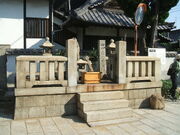
Resting place for Yukimori's decapitated head at Fukuyama, Hiroshima.
Third Attempt[]
Returning to Nobunaga's "shelter", Yukimori and company followed Nobutada to attack Matsunaga Hisahide. During the siege at Kataoka Castle, a middle aged Yukimori defeated one of Hisahide's generals, Kawai Shōgen. Their success rebuilt some of Nobunaga's confidence for the stranded Amago. Therefore, he ordered Katsuhisa to support Hideyoshi at Chūgoku. Katsuhisa was sent under the watchful eye of the Ukita clan in Harima Province. The young lord was given orders to defend Kōzuki Castle, which was where Yukimori and the remnant Amago stayed. At last gaining a base for themselves, efforts for restoration began.
Terumoto desired to end their plans and to completely negate future Amago threats. In March 1578, he assembled a massive army consisting of his two uncles and a reliable navy. With at least 100,000 strong, Terumoto's forces marched to Takamatsu Castle in order to end the Amago. Katsuhisa was guarded at Kōzuki Castle by Yukimori and a handful of Amago retainers, their numbers totaling to at least 3,000. Hideyoshi's forces in the meantime numbered with at least 72,000.
Since Hideyoshi was occupied with simultaneously attacking Miki Castle, the forces he could send to Kōzuki Castle were a dwindled 17,000. Faced with the deep trenches and fortifications of the massive Mōri army, their numbers looked dwarfish as the Amago were surrounded. During the initial skirmishes, Yukimori bravely led a handful of the defenders to battle but became lethargic against the imposing wave of soldiers. Despite his efforts to rally the men, morale for the Amago dimmed and their situation looked grim when their water and food supplies were cut. Several Amago soldiers fled from the area, many not having the spirit to attack the Mōri.
As Hideyoshi watched the situation unfold from Takakurayama, he pondered if he should risk his forces against the Mōri's larger numbers. Sometime in June, he secretly deployed to Kyoto and met with Nobunaga to discuss the matter. Nobunaga answered by placing priority on Miki Castle: to deal with Bessho Nagaharu and to cut off the Mōri's escape route. Another version has him instead order Hideyoshi to bolster the defenses against the Honganji rebels and Uesugi Kenshin. He made no mention of saving the isolated Amago forces, practically turning his back on them. Hideyoshi accepted his orders but felt torn to leave them behind. He sent a letter requesting that they desert Kōzuki Castle and rejoin his army. Either the message was interrupted or ignored because the Amago refused to leave from their position. Apparently, they chose to fight to the death against Terumoto. Hideyoshi didn't have time to reconsider his options since he was also placed into a dangerous situation when the Mōri army anticipated his withdraw. He and his troops suffered a deafening beating against the Mōri's superior coordination, Hideyoshi's army struggling harshly during their escape.
Hideyoshi would eventually avenge this loss, yet his defeat signaled the end of the Amago's resolve. As they were surrounded by songs of victory from the Mōri troops, Katsuhisa, his son and his uncles issued a surrender to the Mōri. They committed suicide a week afterward. Before he killed himself, Katsuhisa apparently turned to Yukimori and confided, "Rather than abide by your oath, you have bowed to your own glory." In this interpretation, his lord didn't believe in his vassal's obligations to the Amago, thinking that he selfishly led them to war in order to relish victory. Conversely, literature depicted Katsuhisa as being positive towards his vassals, thanking them for their years of loyalty during his short time as the clan leader. He naively wished for them to live long and fulfilling lives, hoping they wouldn't follow him to the afterlife.
Two days later, the gates of Kōzuki Castle opened and Yukimori -who futilely struggled in literature- was captured. He was taken to meet Terumoto at Tomonoura, but, as his escort passed through Gōnodō or Ai Transfer, they were ambushed and Yukimori was killed. According to legend, it was actually an assassination. Before the prisoner left, Motoharu feared Yukimori posed too great a threat to leave alive and therefore ordered the Amago general's death. It's also said that Kobayakawa Takakage and Terumoto agreed with Motoharu's assessments and collectively agreed to kill Yukimori. So long as he lived, they thought, the attempts to revive the Amago could still be possible.
Yukimori died at the young age of 34, ending any further efforts of reviving the Amago. His eldest son, Yukimoto, is thought to have founded the Kōnoike Zaibatsu during the Edo Period. His two daughters were forced to abandon the Yamanaka name to continue living. Yukimori's wife became a nun following her husband's death and took the name Takamastu-In.
Etymology[]
- The name Shikanosuke means "deer, venison" (鹿) (shika), "this" (之) (no) and "help, rescue, assist/assistant/assistance" (助) (suke).
- Shikanosuke's surname Yamanaka means "among the mountains" (山中).
Real Name[]
- The name Yukimori means "prosperity" (幸盛).
- Yukimori's surname Yamanaka means "among the mountains" (山中).
Gallery[]
Gallery
|
|---|
100man-nin no Nobunaga no Yabou portrait Nobunaga no Yabou 201X portrait Yamanyaka Shikanosuke in Samurai Cats
Yukimori Yamanaka in Guntama |


